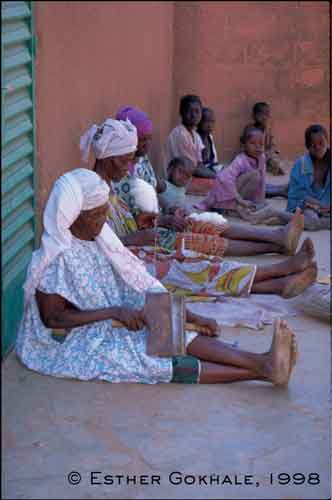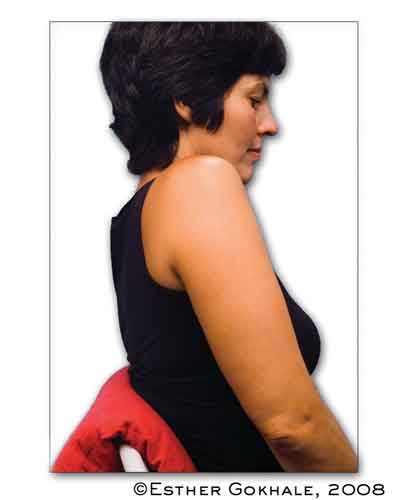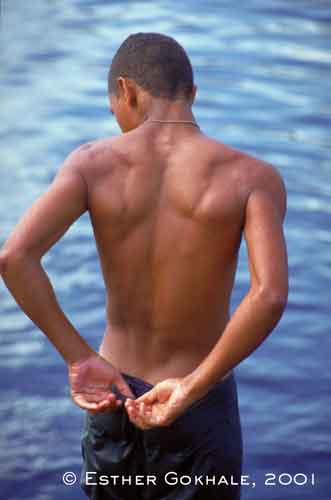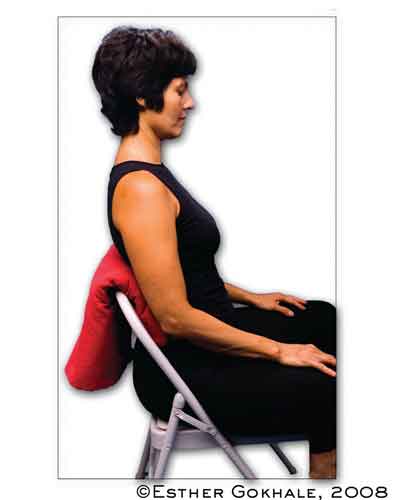
GOKHALE METHOD: BANISH PAIN BY RELEARNING PROPER POSTURE
Dr. Mercola
An important principle to embrace is that pain is typically a good thing as it can help us identify something in our lives that is not good for our long term health.
Back pain is one of the most common pains that people experience and some experts estimate that around 80 percent of us will experience back pain at some point in life. I was certainly in the 80 percent, largely as a result of the time I spent working at the computer. My exercise regimen was not enough to compensate for the damage I was doing while sitting.
I have recently learned that non-exercise movement and posture are two incredibly important yet sorely neglected baselines for health. The more I learn about them, the more convinced I am that posture and non-exercise movement are every bit as important as regular exercise in terms of importance.
Of course, you need both, and I’m not advocating giving up your fitness routine for postural exercises. But proper posture and properly using your body to work against gravity is the foundation upon which everything else related to your health is built.
We know about the importance of diet, exercise, and emotional health, but the fourth pillar, structural health, has for the longest time remained off the radar.
Esther Gokhale’s mission is to educate people on the importance of good posture, which is actually quite different from what is normally taught, such as “sit up straight,” “stand up straight,” and “tuck your pelvis.” According to Esther, virtually all the current guidelines are problematic.
Back Pain Can Be Eliminated Through Simple Posture Training
An estimated 80 percent of the US population will experience back pain at some point in their life, and learning proper posture is crucial if you want to avoid this fate. Esther was herself a statistic, as she developed severe back pain during her pregnancy.
She ended up having back surgery in her 20s to remedy the problem, but soon thereafter the pain came back. Rather than opting for a second surgery, she began her quest to discover the root of her problem.
“The directions that made sense to me were looking for something in my own body. It had to be something about the way I was using my body, rather than looking for a patch, looking for something to alleviate the symptoms alone. I wanted a solution that addresses the root cause,” Esther says.
Her journey has taken her around the world—to India, Brazil, and Europe—and incorporating her knowledge of yoga, pilates, Indian dance and Chinese Medicine, she eventually created the Gokhale Method.
Esther is no stranger to Mercola.com either. She tells me she’s been following the newsletter for a while now, and I’m delighted to have the opportunity to share her knowledge and wisdom with you as this is such a crucial component of staying healthy.
I’ve been a big fan of exercising my whole life, but the principles taught not only by Esther, Dr. Joan Vernikos and Dr. Eric Goodman, are crucial for optimal health. The interaction with gravity is crucial, and- exercise movements that act against gravity while maintaining proper posture are important for all of us.
Everyone wants to age gracefully and be flexible and pain-free, and I think applying what Esther teaches is a profoundly important tool to achieve that. As Esther states:
“The point is, if you have healthy posture, everything you do becomes exercise in some measure. Every step you take, if you’re doing it in a healthy way, becomes a rep for your glute strengthening and becomes a stretch for your calf, your soleus, and so on. Healthy posture makes everyday life into exercise—into therapy even.”
Rediscovering Your Primal Posture
Esther wisely sought answers among the most functional populations; people who do not suffer back pain and have a very low incidence of arthritis in their spines, for example. And that’s where she discovered most of her techniques. Experimenting on herself, she was able to avoid the second surgery, and she has been pain free for over 20 years.
“I’ve not had a back twinge or ache – nothing, zero. Now I get to teach other people how to be empowered in their bodies and how to get there quickly,” she says.
A testament to the effectiveness of her techniques is how quickly you can get lasting results. Her course is just six lessons long, each lesson lasting about 1.5 hours if done in a group, or 45 minutes when you do one-on-one sessions. Part of the beauty of her method is that she teaches you everything you need to make you completely independent. You don’t have to see a chiropractor on a regular basis or hire a Pilates trainer for the rest of your life to keep your pain under control.
By understanding the functional biomechanics of your body and working with gravity instead of against it, you learn to optimize the way you move about your life all the time. And, it works! I’m integrating her method with a few other things, such as Foundation Training and standing up at regular 10-minute intervals as advised by Dr. Joan Vernikos, author of Sitting Kills, Moving Heals. They do make a difference. I recently went hiking in Yosemite National Park for five days and remained completely free of low back pain. In the past, it was hard to do one hike without back pain.
The Difference Between Flexibility and Laxity
Esther was a yoga teacher before her back pain set in, over 20 years ago, and there’s a lot of wisdom in any discipline that’s been around as long as yoga has. However, she points out that yoga is often misunderstood in the modern context.
“People are going for touching their toes rather than the principle of extending your limits and while keeping your baseline sound,” she says. “You want the integrity of your structure to remain intact. For example, your spine, it has a certain baseline shape that’s healthy. You don’t want to round your back just to make sure you touch the floor or your toes.”
There’s a big difference between developing flexibility, which would be in your muscles, and laxity, which occurs when your ligaments are no longer intact. As Esther points out, the danger of repeatedly rounding your back in one spot is that it creates ligament laxity. You really do not want your back to be curved. You want to maintain a straight spine with strong ligaments.
Most people reading this either have a desk job or are sitting down most of the day. This is absolutely true for me. I’m in a chair for at least 12 hours a day. I noticed that my health was starting to decline – not my biological health, but my structural or musculoskeletal health – even though I was exercising; doing a lot of strength training, and what I thought was flexibility training. Now I know why. I simply didn’t know how to maintain proper posture. Improper posture not only affects you while sitting, but it can also make you more prone to exercise injuries and/or pains resulting from exercise.
Roll Your Shoulders Back
One of the first techniques Esther teaches her students is the shoulder roll. It’s easy, effective, and virtually impossible to mess up. Doing one shoulder at a time, simply bring your shoulder forward a little bit, then bring it upward a little, and then bring it as far back as you can. Then, totally let it go and relax.
“You’ll find that your shoulder will actually remain back,” she says. “So, forward, up, back, and then totally let go. Let go of any effort to hold your shoulders back and to stand up straight or sit up straight. Those are, by the way, very counterproductive guidelines, in my view.”
This technique repositions your shoulders, and the soft tissue of the back of your shoulder maintains it, unless, of course, you reach forward and displace the tissues.
Otherwise, your shoulders will easily remain in their proper position for some time, which will improve other biological functions, such as your breathing and blood circulation to and from your arms. It also helps prevent repetitive stress injuries like carpal tunnel syndrome, as well as cold hands and dry skin.
“It takes a little getting used to,” Esther says. “Because when people first do this, they feel like they have little dinosaur arms that don’t reach very far. But it is actually the natural way to use your arms. Every one of your great, great grandparents had their shoulders parked in this baseline position that is quite far back. If you look at the back, the shoulder blades should protrude from the torso; they should not be flush with the torso.”
How to Improve Your Head, Neck and Spine Posture
Esther refers to proper posture as primal posture, because it’s the posture of infants and native hunter-gatherers. One of the most troublesome postures of modern society is keeping your head thrust too far forward. Ideally, your ears should be above your shoulders, and to get there, you want to pull your head and neck back—typically about 45 degrees, depending how far forward your head is.
“One technique I like better than just telling people to push back is to pull back, because then you’re not tensing up some muscle to try to fight some other type of muscle. It’s like having the break and the accelerator on at the same time. You don’t want to sustain this tension,” Esther explains. “Instead, grasp a clump of hair, then very gently pull back and up, and then just relax your neck. Let your chin relax down rather than pushing it down and pushing it back.”
Another crucial area is your spine. You want to lengthen or elongate your spine, and maintain your buttocks out behind you rather than tucked in. Most conventional advice tells you to tuck in your pelvis to maintain an S-shaped spine, but a far more natural spine curvature is what Esther refers to as a J-spine. Here, your back is straight and your buttocks protrude slightly.
“There are two areas of the spine that get into more trouble than any other: (1) cervical spine and (2) lumbar spine. A lot of the problems that occur here are compression-related problems: stenosis, sciatic pain, and scoliosis even. So, lengthening is a really, really good first measure,” Esther says.
Maintaining this J-curve, which she describes really well in her book, 8 Steps to a Pain-Free Back, is really crucial for good posture. You can also find free PDF downloads describing this posture on her website, GokhaleMethod.com1. Again, the body part of the “J” corresponds to your behind, slanting out behind you. If you examine how toddlers stand, they stand with a straight back, the lumbar area remaining relatively flat, with their bottoms out behind them. This posture is maintained into adulthood by many tribal peoples.

Remember Primal Posture when Sitting, and Stand up Frequently
Research has repeatedly shown that prolonged sitting has detrimental effects on your body even if you’re exercising regularly. I recently interviewed Dr. Vernikos on this topic and what she refers to as gravity habits or “G habits.” Her job as a NASA doctor was understanding how microgravity situations affect health, because it ostensibly appears to rapidly speed up the aging process. G habits are movements that are quantified as non-exercise activities, and the challenge is to get more of them into your daily life.
One such movement is standing up from a seated position—ideally around 35 times a day—to counteract the cardiovascular health risks associated with sitting. This amounts to standing up about every 10 minutes or so throughout your workday, for example. I set a timer to go off at regular 10-minute intervals, and while I’m at it, I do some jump squats or one-legged squats as well.
Based on double-blind research, Dr. Vernikos discovered that standing up once every hour was more effective than walking on a treadmill for 15 minutes for cardiovascular and metabolic changes. She also found that sitting down and standing up repeatedly for 32 minutes does NOT have the same effect as standing up once, 32 times over the course of a day. To get the benefit, the stimulus must be spread throughout the day. Hence the suggestion to set a timer to remind you to get out of your chair at regular intervals.
Now, in addition to getting out of your chair frequently enough, maintaining proper posture while sitting can also make a significant difference, as poor posture might play a significant role in sitting’s detrimental effects on health. As Esther explains:
“For example, in our stack sitting method (which is really healthy sitting, primal sitting, if you will), you have your behind out behind, but not exaggeratedly. That’s very important. Then your bones stack well and the muscles alongside your spine are able to relax. They’re not obliged to be tense. Now when you breathe, your whole spine lengthens and settles, lengthens and settles. There’s this movement which stimulates circulation and allows natural healing to be going on as you sit.
If you sit poorly, whether relaxed and slumped or upright and tense, you’ve lost all of that. So do we want to blame [all the adverse health effects] on sitting, or do we want to blame it on the poor sitting form? That’s my question.”
Techniques to Elongate Your Spine
Esther recommends using your back rest as a traction device to help you elongate your spine. You can see her demonstrate this move toward the end in the video above. She also sells a specially designed traction cushion and even a chair for this purpose, but you could also use a rolled up towel.
“It’s a one- to two-second maneuver to bring your back away from the back rest, lengthen, and then root yourself a little higher against the back rest. Now, the whole time you’re sitting, your lower back is getting a little bit of traction. That is such a powerful way to change sitting into something that’s actually beneficial in some part rather than entirely damaging.”
By using some traction device in your chair to help you elongate your spine when sitting, you will start flattening out your lumbar area. This alone can sometimes provide immediate relief if your pain is due to compression of your sciatic nerve roots. Her Stretch Sit cushion is designed to “hitch” your midback so your L5/S1 and L4/L5 discs, which are the discs that cause the most trouble for the most people, are decompressed.
By getting traction on those discs, you allow them to rehydrate and prevent the nerves from being impinged between your vertebrae.
Anyone suffering with back pain would be wise to consider Esther’s advice on posture. One of the key factors for treating your pain is to elongate your spine as much as possible. So be mindful to use her “stretch sitting” technique demonstrated above regardless of where you sit. Do it while driving, while at your desk, and on the couch. You can also add some length to your spine while lying down. Esther calls this “stretchlying,” and the technique is demonstrated in the video below.
Develop Your Inner Corset
Esther also teaches a technique she calls “the inner corset,” where you engage your deepest layer of abdominal muscles and your deepest layer of back muscles. This technique, when applied, actually has a slenderizing effect, and makes you taller.
“I call that the inner corset because it’s different from what people teach under the name of core strength,” Esther explains. “It does not involve rectus abdominis. You’re not tucking your pelvis. You’re keeping your J-spine while going slender and tall.”
This takes pressure off the nerves in your spine and allows for your discs to rehydrate.
Be aware that in the beginning, you will not be able to hold this posture all day long. But eventually, as your abs and back muscles get stronger from repetition, this posture will become quite natural.
Good posture is the foundation of physical health, musculoskeletal health, and even psychological health. The reason for this is because it allows your body to operate as it was designed to, providing an ideal architecture for your lungs to move freely and for your digestive organs to function without blockages for example. By tucking your pelvis, you lose about a third of the volume in your pelvic cavity, which squishes your internal organs. This can compromise any number of them in a variety of ways.
More Information
Remember, proper posture and properly using your body to work against gravity is the foundation upon which everything else relating to your health is built. Relearning proper posture can feel odd at first, especially if you’re severely out of alignment. But if you stick with it, the results can be life-changing.
“When we place people [in proper posture], they say, 'Whoa, this feels so weird. I feel like I’m falling flat on my face. I feel like I’m a Neanderthal.' It takes us showing them their reflection in the mirror to be astonished. They may feel weird, but they don’t look weird. It isn’t weird, but it’s so far away from what they’ve been doing,” Esther says.
Esther’s book, 8 Steps to a Pain-Free Back, contains over 1,000 illustrations and photographs and is an excellent manual. She also has a DVD that provides demonstrations of all her techniques. If you want to go to the next step, you can find a teacher of Gokhale Method on her website, GokhaleMethod.com2. You can also find more videos like the ones included in this article on YouTube.
VIEW VIDEOS





